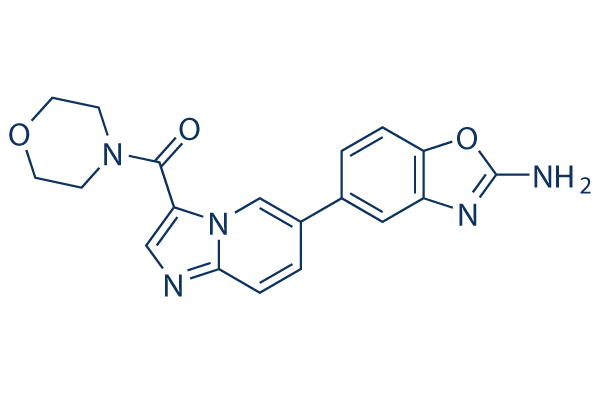All AbMole products are for research use only, cannot be used for human consumption.

In vitro: TAK-117 administration in PIK3CA-mutant tumor cell lines results in potent PI3K pathway inhibition, blockade of cellular proliferation, and apoptosis. INK1117 potently inhibits PI3K and demonstrates a greater than 100-fold selectivity relative to other class I PI3K family members and mTOR as well as a high degree of selectivity against a large panel of protein kinases. INK1117 blocks proliferation of tumor cell lines bearing PIK3CA mutations, and inhibits cellular phosphorylation and activity of AKT. However, INK1117 shows much less activity in PTEN-deficient tumor cells, which typically display constitutive PI3K pathway activation independent of PI3Kα.
In vivo: Administration of TAK-117 leads to dose-dependent inhibition of tumor growth in murine xenograft models of human cancer (e.g., breast carcinoma) bearing PIK3CA oncogenic mutations, with corresponding inhibition of PI3K pharmacodynamic markers in tumor tissue. Preclinical antitumor activity of single-agent TAK-117 has been shown to be independent of dosing schedules and driven by total plasma exposures. Conversely, TAK-117 is not efficacious in tumor models harboring PTEN and/or KRAS mutations. Preclinical studies show TAK-117 to have low potential for disrupting glucose metabolism or for causing cardiac adverse events; in rats and monkeys, doses up to 50 mg/kg/day were well tolerated. In human, The mean terminal half-life of TAK-117 is approximately 11 hours (range, 6-14 hours). There is no meaningful accumula-tion of TAK-117 with repeated dosing for any schedule. Additionally, INK1117 does not significantly impair B and T cell function in vitro and in vivo.
| Cell Experiment | |
|---|---|
| Cell lines | NK cells |
| Preparation method | |
| Concentrations | 1 μM |
| Incubation time | 20 min |
| Animal Experiment | |
|---|---|
| Animal models | C57BL/6 mice |
| Formulation | |
| Dosages | 60 mg/kg |
| Administration | oral |
| Molecular Weight | 363.37 |
| Formula | C19H17N5O3 |
| CAS Number | 1268454-23-4 |
| Solubility (25°C) | 16 mg/mL in DMSO |
| Storage |
Powder -20°C 3 years ; 4°C 2 years In solvent -80°C 6 months ; -20°C 1 month |
| Related PI3K Products |
|---|
| T-00127-HEV1
T-00127-HEV1 is a phosphatidylinositol 4-kinase III beta (PI4KB) inhibitor with an IC50 of 60 nM. |
| PI3Kγ inhibitor AZ2
PI3Kγ inhibitor AZ2 is a highly selective PI3Kγ inhibitor (The pIC50 value for PI3Kγ is 9.3). |
| NIBR-17
NIBR-17 is a pan-class I PI3K inhibitor with suitable pharmacokinetic properties and inhibits tumor growth. |
| RV-1729
RV-1729 is an inhibitor of the phosphatidylinositol 3-kinase-δ (PI3Kδ). |
| Vulolisib
Vulolisib is a potent and orally active phosphatidylinositol 3-kinase (PI3K) inhibitor, with IC50 values of 0.2 nM, 168 nM, 90 nM and 49 nM for PI3Kα, PI3Kβ, PI3Kγ and PI3Kδ, respectively. |
All AbMole products are for research use only, cannot be used for human consumption or veterinary use. We do not provide products or services to individuals. Please comply with the intended use and do not use AbMole products for any other purpose.


Products are for research use only. Not for human use. We do not sell to patients.
© Copyright 2010-2024 AbMole BioScience. All Rights Reserved.
